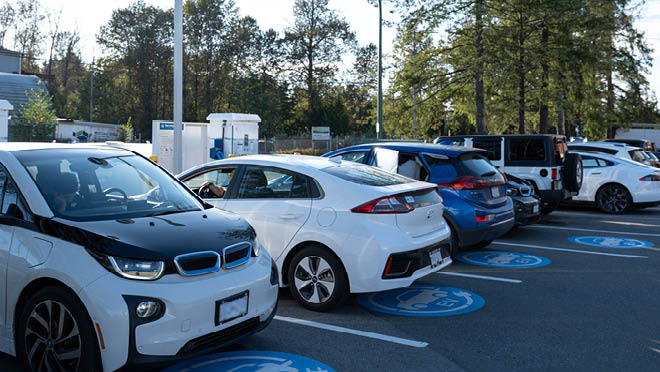Electric vehicle technologies and types

Spend less on gas with a hybrid or battery electric vehicle
There are four different electric vehicle (EV) types, which we've highlighted below. Plug-in electrical vehicles describe all vehicles that have a battery that can be charged through an electrical outlet. This is the type of vehicle BC Hydro typically focuses on, but there are other types as well. That being said, across the electric vehicle community, 'EV' is the accepted generic term for them all.
Battery EVs
(BEVs, or more commonly, EVs)
A battery electric vehicle is powered entirely by a battery and single or dual electric motors. Battery EVs don't use any gas and have to be plugged into a charger.
Like all electric vehicles, BEVs can also recharge their batteries through regenerative braking. This means that instead of using the brakes, the electric motor(s) slow down the vehicle. They are then able to capture that energy and feed it back into the battery.
Plug-in hybrid EVs
(PHEVs)
A plug-in hybrid vehicle (PHEV) runs mostly on batteries recharged by plugging into the power grid. But it also has a gas-powered internal combustion engine. The combustion engine rechargers the battery while driving. It can also replace the electric motor when the battery is low and more power is required.
PHEVs are often cheaper and cleaner to run than traditional hybrid vehicles (HEVs). You'll still need to buy gas — but far less frequently, because they can be recharged by the power grid.
Hybrid EVs
(HEVs)
Hybrid vehicles (HEVs) were made popular by the second generation Toyota Prius. They have two complementary drive systems that run simultaneously. A gas-powered engine and fuel tank is accompanied by an electric motor and a battery. But don't confuse HEVs with PHEVs: HEVs are not plug-ins, as they can't be recharged from the power grid.
Fuel-cell EVs
(FCEVs)
A fuel-cell electric vehicle uses on-board fuel cells to generate electricity and power an electric motor. This process uses hydrogen in the fuel cells and oxygen to generate electricity. A fuel-cell vehicle only takes a few minutes to refuel. For this quick refuel time, it has a range of about 600 kilometre, and emits only water from its exhaust.
Currently, there are a limited number of public hydrogen refuelling stations in B.C. However, more are under construction.